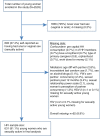Transactional sex among young women in rural South Africa: prevalence, mediators and association with HIV infection
- PMID: 27469061
- PMCID: PMC4965597
- DOI: 10.7448/IAS.19.1.20749
Transactional sex among young women in rural South Africa: prevalence, mediators and association with HIV infection
Abstract
Introduction: Young adolescent women in sub-Saharan Africa are three to four times more likely to be HIV-positive than boys or men. One of the relationship dynamics that is likely to be associated with young women's increased vulnerability to HIV is transactional sex. There are a range of HIV-related risk behaviours that may drive this vulnerability. However, to date, limited epidemiological data exist on the role of transactional sex in increasing HIV acquisition, especially among young women in sub-Saharan Africa. Our paper presents data on the prevalence of self-reported engagement in transactional sex and explores whether transactional sex is associated with increased risk of HIV infection among a cohort of young, rural, sexually active South African women. We also explore whether this relationship is mediated through certain HIV-related risk behaviours.
Methods: We analyzed baseline data from a phase III trial of conditional cash transfers for HIV prevention of 693 sexually active, school-going young women aged 13-20 years in rural South Africa. We examined the association between young women's engagement in transactional sex and HIV infection. Transactional sex is defined as a non-commercial, non-marital sexual relationship whereby sex is exchanged for money and/or gifts. We explored whether this relationship is mediated by certain HIV-related risk behaviours. We used logistic and multinomial regression and report unadjusted and adjusted odds ratios with 95% CI.
Results: Overall, 14% (n=97) of sexually active young women reported engaging in transactional sex. Engagement in transactional sex was associated with an increased risk of being HIV-positive (aOR: 2.5, CI: 95% 1.19-5.25, p=0.01). The effect size of this association remained nearly unchanged when adjusted for certain other dimensions of HIV risk that might help explain the underlying pathways for this relationship.
Conclusions: This study provides quantitative support demonstrating that transactional sex is associated with HIV infection in young women. Even though the specific variables tested do not mediate the relationship, a potential explanation for this association may be that the men with whom young women are having sex belong to networks of sexually connected individuals who are at a "high risk" for HIV infection. The results highlight the importance of structural intervention approaches that can alter the context of young women's HIV risk.
Keywords: HIV; adolescent women; risky sexual behaviours; structural drivers; sub-Saharan Africa; transactional sex; young women.
Figures



Similar articles
-
'It's because I like things… it's a status and he buys me airtime': exploring the role of transactional sex in young women's consumption patterns in rural South Africa (secondary findings from HPTN 068).Reprod Health. 2018 May 29;15(1):102. doi: 10.1186/s12978-018-0539-y. Reprod Health. 2018. PMID: 29843814 Free PMC article. Clinical Trial.
-
Young women's perceptions of transactional sex and sexual agency: a qualitative study in the context of rural South Africa.BMC Public Health. 2017 Aug 22;17(1):666. doi: 10.1186/s12889-017-4636-6. BMC Public Health. 2017. PMID: 28830394 Free PMC article.
-
Child-focused state cash transfers and adolescent risk of HIV infection in South Africa: a propensity-score-matched case-control study.Lancet Glob Health. 2013 Dec;1(6):e362-70. doi: 10.1016/S2214-109X(13)70115-3. Epub 2013 Nov 26. Lancet Glob Health. 2013. PMID: 25104601
-
Revisiting the understanding of "transactional sex" in sub-Saharan Africa: A review and synthesis of the literature.Soc Sci Med. 2016 Nov;168:186-197. doi: 10.1016/j.socscimed.2016.09.023. Epub 2016 Sep 15. Soc Sci Med. 2016. PMID: 27665064 Review.
-
Improving the Measurement of Transactional Sex in Sub-Saharan Africa: A Critical Review.J Acquir Immune Defic Syndr. 2019 Apr 1;80(4):367-374. doi: 10.1097/QAI.0000000000001928. J Acquir Immune Defic Syndr. 2019. PMID: 30789453 Free PMC article. Review.
Cited by
-
Temporal shifts in HIV-related risk factors among cohorts of adolescent girls and young women enrolled in DREAMS programming: evidence from Kenya, Malawi and Zambia.BMJ Open. 2022 Feb 1;12(2):e047843. doi: 10.1136/bmjopen-2020-047843. BMJ Open. 2022. PMID: 35105561 Free PMC article.
-
Sexual Partner Types and Incident HIV Infection Among Rural South African Adolescent Girls and Young Women Enrolled in HPTN 068: A Latent Class Analysis.J Acquir Immune Defic Syndr. 2019 Sep 1;82(1):24-33. doi: 10.1097/QAI.0000000000002096. J Acquir Immune Defic Syndr. 2019. PMID: 31169772 Free PMC article.
-
Conceptualization of Empowerment and Pathways Through Which Cash Transfers Work to Empower Young Women to Reduce HIV Risk: A Qualitative Study in Tanzania.AIDS Behav. 2020 Nov;24(11):3024-3032. doi: 10.1007/s10461-020-02850-0. AIDS Behav. 2020. PMID: 32236739 Free PMC article.
-
Community perspectives on the extent to which transactional sex is viewed as sexual exploitation in Central Uganda.BMC Int Health Hum Rights. 2020 May 1;20(1):11. doi: 10.1186/s12914-020-00228-w. BMC Int Health Hum Rights. 2020. PMID: 32354329 Free PMC article.
-
Social norms that sustain transactional sex and associations with sexual health outcomes: A mixed-methods study in the Comarca Ngäbe-Buglé, a rural-Indigenous region of Panama.PLoS One. 2024 May 31;19(5):e0304805. doi: 10.1371/journal.pone.0304805. eCollection 2024. PLoS One. 2024. PMID: 38820484 Free PMC article.
References
-
- UNAIDS. UNAIDS; Joint United Nations Programme on HIV/AIDS (UNAIDS); 2012. Global report: UNAIDS report on the global AIDS epidemic.
-
- UNAIDS. Global AIDS response progress report [Internet] 2012. [cited 2015 Oct 10]. Available from: http://www.unaids.org/en/dataanalysis/knowyourresponse/countryprogressre....
-
- Gilbert L, Walker L. Treading the path of least resistance: HIV/AIDS and social inequalities a South African case study. Soc Sci Med. 2002;54(7):1093–110. - PubMed
-
- Dellar RC, Dlamini S, Karim QA. Adolescent girls and young women: key populations for HIV epidemic control. J Int AIDS Soc. 2015;18(2 Suppl 1):19408. doi: http://dx.doi.org/10.7448/IAS.18.2.19408. - DOI - PMC - PubMed
MeSH terms
Grants and funding
LinkOut - more resources
Full Text Sources
Other Literature Sources
Medical

